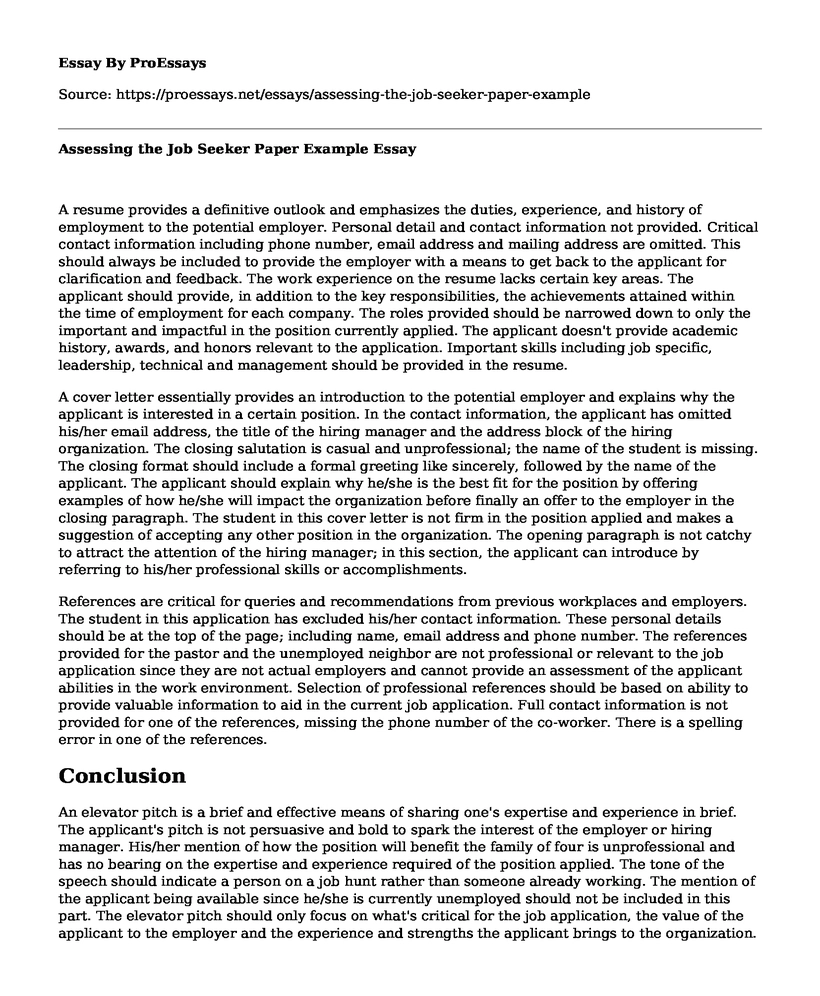A resume provides a definitive outlook and emphasizes the duties, experience, and history of employment to the potential employer. Personal detail and contact information not provided. Critical contact information including phone number, email address and mailing address are omitted. This should always be included to provide the employer with a means to get back to the applicant for clarification and feedback. The work experience on the resume lacks certain key areas. The applicant should provide, in addition to the key responsibilities, the achievements attained within the time of employment for each company. The roles provided should be narrowed down to only the important and impactful in the position currently applied. The applicant doesn't provide academic history, awards, and honors relevant to the application. Important skills including job specific, leadership, technical and management should be provided in the resume.
A cover letter essentially provides an introduction to the potential employer and explains why the applicant is interested in a certain position. In the contact information, the applicant has omitted his/her email address, the title of the hiring manager and the address block of the hiring organization. The closing salutation is casual and unprofessional; the name of the student is missing. The closing format should include a formal greeting like sincerely, followed by the name of the applicant. The applicant should explain why he/she is the best fit for the position by offering examples of how he/she will impact the organization before finally an offer to the employer in the closing paragraph. The student in this cover letter is not firm in the position applied and makes a suggestion of accepting any other position in the organization. The opening paragraph is not catchy to attract the attention of the hiring manager; in this section, the applicant can introduce by referring to his/her professional skills or accomplishments.
References are critical for queries and recommendations from previous workplaces and employers. The student in this application has excluded his/her contact information. These personal details should be at the top of the page; including name, email address and phone number. The references provided for the pastor and the unemployed neighbor are not professional or relevant to the job application since they are not actual employers and cannot provide an assessment of the applicant abilities in the work environment. Selection of professional references should be based on ability to provide valuable information to aid in the current job application. Full contact information is not provided for one of the references, missing the phone number of the co-worker. There is a spelling error in one of the references.
Conclusion
An elevator pitch is a brief and effective means of sharing one's expertise and experience in brief. The applicant's pitch is not persuasive and bold to spark the interest of the employer or hiring manager. His/her mention of how the position will benefit the family of four is unprofessional and has no bearing on the expertise and experience required of the position applied. The tone of the speech should indicate a person on a job hunt rather than someone already working. The mention of the applicant being available since he/she is currently unemployed should not be included in this part. The elevator pitch should only focus on what's critical for the job application, the value of the applicant to the employer and the experience and strengths the applicant brings to the organization.
Cite this page
Assessing the Job Seeker Paper Example. (2022, Nov 06). Retrieved from https://proessays.net/essays/assessing-the-job-seeker-paper-example
If you are the original author of this essay and no longer wish to have it published on the ProEssays website, please click below to request its removal:
- Gender Discrimination at Workplaces Essay
- The Impact of Job Satisfaction on Employee Retention - Research Paper
- Essay Sample on Job Satisfaction & Organizational Commitment: Distinct Yet Related
- Essay Example on Atterberg Limits: Shrinkage, Plastic & Liquid Limits
- Essay Sample on EZ-Pleeze: Maximizing Employee Performance & Productivity
- My Dream to Advance My Career: Pursuing an MBA in Marketing - Essay Sample
- Essay on Project Manager: Ensuring Project Success in Petrochemical, IT, Architecture & Construction







